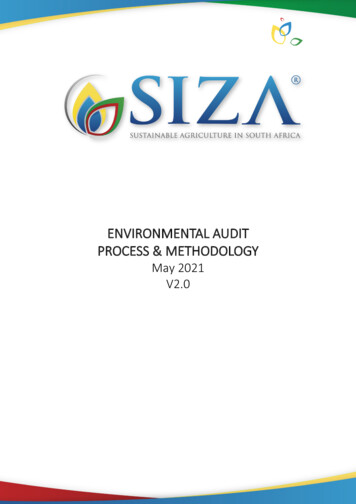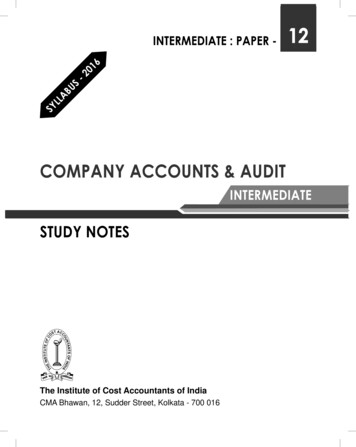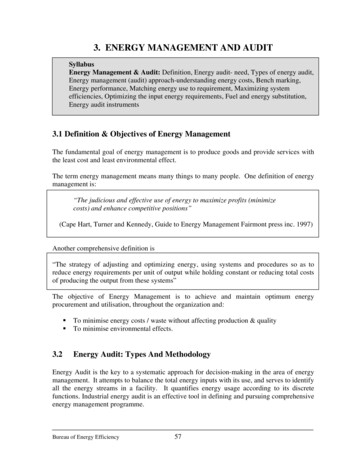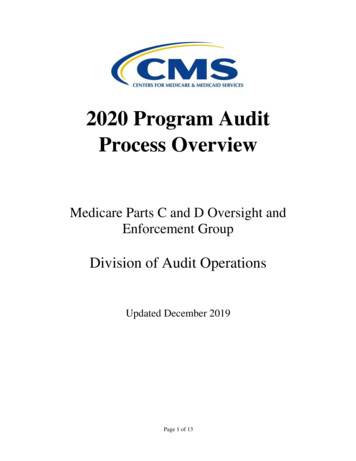
Transcription
ENVIRONMENTAL AUDITPROCESS & METHODOLOGYMay 2021V2.0
SIZA Environmental Audit Process and MethodologyTABLE OF CONTENTS1.2.3.4.5.INTRODUCTION .41.1.Overview of the Audit Process. . . .41.2.Involvement of Auditors and Suppliers in the Audit Process. .41.3.1.3.1.1.3.2.1.3.3.Audit Firms (Auditors) vs Consultants. 4Auditors.5Consultants.5Audit firms/auditors.51.4.Bribery, Corruption, and Undue Influence .51.5.SIZA Environmental Programme Approach.6RISK ASSESSMENT SYSTEM .62.1.Registration on MySIZA . 72.2.Environmental Self‐Assessment Questionnaire.7AUDIT REQUEST.73.1.Launching an Audit request.73.2.Pre‐Audit Employment Site Profile.8PREPARATION.94.1.4.1.1.Background and Context Review (SIZA Preparation Toolkit).9Audit firm.94.2.4.2.1.4.2.2.4.2.3.4.2.4.4.2.5.Audit Organisation.9Audit type.9Audit length.11Multi-site audits.11Audit team.13Audit frequency .134.3.4.3.1.Communicating Audit Arrangements.14Information for the Employment Site.144.4.4.4.1.Supplier Preparation.14Information for workers.15AUDIT EXECUTION.175.1.Opening Meeting.175.2.5.2.1.5.2.2.5.2.3.Employment Site Tour.18Process .18Optional perimeter survey.19Management Interviews.195.3.5.3.1.Document Review.19Document Sampling.192 2021, The Sustainability Initiative of South Africa, NPC. All rights reserved.
SIZA Environmental Audit Process and Methodology6.5.3.2.Document Inconsistencies.205.4.Alert Notifications.205.5.5.5.1.Audit Team Pre‐Closing Meeting.21Non‐compliances, Observations and Good Practice Evaluation.225.6.Closing Meeting .23AUDIT OUTPUTS.246.1.Audit Reports.246.2.Long term Improvement Plans.246.3.6.3.1.Information Management.24Audit records.256.4.6.4.1.Audit Follow‐up.25Follow‐up audits.256.5.SIZA Audit Confirmation Notice.266.6.Extension of Corrective Actions.266.7.Expiry of Corrective Actions.277.GLOSSARY OF TERMS.288.ANNEXURES.303 2021, The Sustainability Initiative of South Africa, NPC. All rights reserved.
SIZA Environmental Audit Process and Methodology1. INTRODUCTION1.1.Overview of the Audit ProcessSIZA manages the audit process from its office in Somerset West and through the MySIZAonline platform, which aims to create visibility throughout the agricultural value chain, forlocal suppliers to buyers from international markets. The MySIZA platform is developed toensure adequate navigation for SIZA members, audit firms, and audit teams.1.2.Involvement of Auditors and Suppliers in the Audit ProcessAuditors and suppliers should be involved as much as possible in the audit process.This can be done in the following ways:Auditors: Sharing briefing notes with the supplier explaining the background, process, applicablecodes, and audit methodology. Sharing best practices and giving examples of “what good looks like” against each topic,with practical advice on ways to address common environmental compliance issues. Encouraging suppliers to request environmental compliance audits themselves to createcontinuous improvement and/or to demonstrate their own commitment toenvironmental stewardship. Audit firms are not allowed to change the audit scope without the approval of SIZA asoutlined by the SIZA Audit Process and Methodology (APM).Suppliers: Ensuring that the business is registered under the correct membership level on MySIZA,since it will influence the audit scheduling and output. Completing Self-Assessment Questionnaire (SAQ) information for approval by SIZA beforethe audit takes place. Information should be accurate, as incorrect information can relateto unnecessary findings. PUCs must be declared on the membership application, otherwise they will be excludedfrom the audit. PUCs, PHCs, and any other product code related to indication which areasform part of the audit must be declared on the supplier’s membership status. If the codeis not included, it means that it does not form part of the audit scope. The distance between sites, as well as the different commodity seasons must beconsidered when the membership level is chosen. Separate payroll and/or management systems must be registered on different profiles. It is important to know that auditors are required to audit the head office, but also toundertake inspection visits at all the production sites forming part of the scope of theaudit. Audits must take place during peak season activities for the auditors to verify as manycontrol points as possible.1.3.Audit Firms (Auditors) vs ConsultantsWhen an audit is scheduled by an audit firm, the responsibilities of the auditor are definedand set. The audit firm will assign an auditor or auditors to the site. This auditor will not beallowed to act as a consultant/assessor to the supplier before, during, or after the audit.The roles and responsibilities of an auditor vs a consultant are as follows:4 2021, The Sustainability Initiative of South Africa, NPC. All rights reserved.
SIZA Environmental Audit Process and Methodology1.3.1.AuditorsThe consulting process is an external process between the supplier and the consultingfirm/consultant. Neither the auditor nor the audit firm can take on the role of both consultantand auditor for the same audit process or at the same business. The role of the auditor andconsultant should be clearly defined prior to an audit.1.3.2.ConsultantsConsultants may confer with the supplier regarding the audit. The consultant may also adviseand guide the supplier before and after the audit, but he/she cannot interfere during theaudit. When all the findings have been reported and documented on MySIZA, the consultantcan assist the supplier in understanding and interpreting the findings and to make thenecessary corrections. Suppliers should employ consultants at their own cost and not as partof an audit. Suppliers should ensure that consultants are knowledgeable and trained on theSIZA APM before appointing them.The consultant cannot take on the role of the client on the day that the audit takes place. It isimportant that the client is present and represented on the day of the audit. Consultants canbe present on the day of the audit, but they can only observe during the audit.1.3.3.Audit firms/auditorsIf an audit firm decides to act as an assessor/consultancy service, this must be managedseparately from the audit department and the auditors who act on behalf of SIZA. Under nocircumstances will a SIZA auditor be allowed to audit at a particular site/facility if that auditor(or any person/company affiliated with the auditor) was involved in consulting or an advisoryrole prior to the audit. It remains the responsibility of the auditor and audit firm to ensurethis is declared by the auditor to the audit firm and scheme. SIZA has the right to reject anaudit if the integrity of the audit was compromised in any way. SIZA must ensure that anyconflict of interest is eliminated and that the audit process is an ethical, honest, andtransparent process.1.4.Bribery, Corruption, and Undue InfluenceAll auditors and audit firms must adhere to fair and ethical practices during the audit process.SIZA is committed to dealing with all parties lawfully, ethically, and with integrity. Thiscommitment will not allow any form of bribery, corruption, or undue influence by any party.These practices are deemed as unacceptable and will not be tolerated. All third parties actingin the interest of or on behalf of SIZA must abide by this commitment.Auditors and audit firm must complete due diligence when entering audit arrangements toensure no party is subject to undue influence, corrupt practices, or attempts of bribery. Auditfirms must allow for any declarations regarding possible practices and procedures that mightbe deemed as unlawful or ethically ambiguous prior, during, and after an audit. Suchpractices may include possible undue influence by offerings of gifts, accommodation,transport, food, or any other practice that may be deemed as deceitful, exploitative, orcorrupt practices.5 2021, The Sustainability Initiative of South Africa, NPC. All rights reserved.
SIZA Environmental Audit Process and Methodology1.5.SIZA Environmental Programme ApproachThe programme follows a seven-step process:Step 1:Step 2:Step 3:Step 4:Step 5:Step 6:Step 7:Compliance TrainingRegistration and Annual Completion of Self-Assessment Questionnaire (SAQ)Audit Preparation and Raising Awareness with EmployeesThird-party AuditCorrective ActionsAudit Completion Letter IssuedMaintaining Compliance through Audit Oversight2. RISK ASSESSMENT SYSTEMA buying company should implement an efficient process to measure environmentalcompliance and identify risks in its supply chain. This will enable the company to focus onpotential key risk areas and direct its verification resources accordingly.Existing risk assessment tools for suppliers include criteria such as: geographical area,suitability of production areas, monitoring the usage and availability of natural resources,identifying, and measuring the residues of production activities, nature of production, level ofsupplier commitment, and/or previous verification results.This information upon which the risk assessment is based, is provided by the supplier oremployment site either through a SAQ or through questions asked as part of the commercialrelationship.6 2021, The Sustainability Initiative of South Africa, NPC. All rights reserved.
SIZA Environmental Audit Process and Methodology2.1.Registration on MySIZAThe supplier must register on the MySIZA platform. It is important that the supplier choosesthe correct membership level according to the specifications of the farm(s)/packhouse(s)/business and that he/she takes the audit process into account when choosing themembership level. Membership renewal is due annually and consist out of a 3-step approachi.e., paying your membership fee; sending your proof of payment to SIZA admin; and updatingyour SAQ to ensure that you have an approved SAQ at all times. The pricing structure willdepend on the membership level, the use of the different SIZA modules and on the level ofvisibility to be provided to the market.SIZA is a not-for-profit service entity for the agri-sector. All membership fees are thereforeused to create capacity and support through the SIZA office and to enable furtherdevelopment, functionalities, and benefits on the MySIZA data platform and through trainingprogrammes.2.2.Environmental Self‐Assessment QuestionnaireThe SAQ must be completed by the SIZA member/supplier on MySIZA. The SAQ enables asupplier or employment site to provide information about the employment site, how itmanages environmental compliance and its performance against local and internationalenvironmental conservation standards. The employment site is asked to respond to a seriesof questions and provide supporting documentation.Once completed and submitted on MySIZA, the SAQ is evaluated by SIZA admin foracceptance and the member is duly notified of said acceptance. If rejected by SIZA, themember is notified and must correct the areas indicated and resubmit the SAQ for review.This process must be repeated until the SAQ is approved.SAQs must be updated annually within 90 days from the annual renewal of the profile. Ifsuppliers lapse in updating their SAQs, their Audit Completion Letters will no longer be valid.The status of the SAQ will be visible to buyers on the risk reports. Although suppliers areallocated a Platinum, Gold, Silver, or Bronze status after an audit (which is valid for one, two,or three years depending on the status), they must renew their membership and update theirSAQs annually. One of the conditions of the two to three-year audit period is that SIZA mustmonitor whether members maintain environmental conservation practices and standardsduring that time. SIZA must also review the updated SAQ annually to monitor if anything haschanged on the farm during the specified period. If membership is not renewed and the SAQis not updated annually, visibility on the SIZA, Sedex, and GLOBALG.A.P. databases will also becompromised, and the Audit Completion Letter cannot be validated. Once registration iscompleted and the SAQ is approved, the supplier can request to be audited via MySIZA. Thebuying company may then register on MySIZA and use it to access the supplier’sinformation to use as a basis for risk assessment.The auditor must use information from the SAQ in preparation of the audit to focus theonsite investigation on high-risk areas.3. AUDIT REQUEST3.1.Launching an Audit requestOnce the Environmental SAQ has been approved on MySIZA, the SIZA member/employmentsite can submit an audit request through the online system. If audit firms fail to maintain their7 2021, The Sustainability Initiative of South Africa, NPC. All rights reserved.
SIZA Environmental Audit Process and Methodologymembership profile by keeping it active on MySIZA, they will unfortunately not be visible tosuppliers as an option to choose as an audit firm.Audit firm must make sure that suppliers are active members of SIZA and have an approvedEnvironmental SAQ before they schedule an audit. SAQs must be approved at least sevenworking days before the audit takes place.SIZA will not accept any audits which were arranged through the audit firm without thesupplier having an approved SAQ and an active SIZA membership on MySIZA. Audit firms arenot permitted to schedule an audit if it was not initially requested online by the SIZA memberon MySIZA. Auditors will not be able to access the supplier’s profile on MySIZA if the auditwas not scheduled online. Audit firms must ensure that they stay up to date with thescheduling of audit requests and that they respond to the supplier as soon as possible. Anyaudit request that has not been scheduled on MySIZA within three months will be removedfrom the audit firm’s profile. The auditee then has the option to choose another audit firm.Once the request has been received by the audit firm, the audit scheduler must assign anaudit team (lead and associate auditors and a reviewer) to the audit. This is an online processon MySIZA. The auditor and the reviewer cannot be the same individual, and an auditorcannot audit the same facility consecutively more than twice.An audit request may be made by SIZA members that may be: The employment site The supplier The buying company SIZA Any other party with an interest in the commercial relationship and environmentalperformance of the employment site. For example, the industry bodies.Any company or organisation requesting an audit is termed an ‘audit requestor’.3.2.Pre‐Audit Employment Site ProfileThe information required to compile a pre-audit employment site profile is generated onMySIZA. When an audit request is made, the SIZA member will select the audit firm whichthey wish to conduct the audit. MySIZA will submit this request to the audit firmelectronically. The audit firm will then automatically have access to information relevant tothe pre-audit employment site profile, comprising of general information about the company,employment site, location, size, environmental management practices, and productionprocesses.This information allows auditors to: Prepare relevant briefing materials (industry or country-specific) Plan the assessment, for example the gender and language capabilities of the auditteam members and the required number of auditor days (cf. 4.2.2 Audit length).Each employment site to be audited will have completed a pre‐audit employment siteprofile as part of their SIZA member profile and SAQ submission on MySIZA. The auditorshould use the information provided by the supplier along with the information provided tothe audit firm when the audit is requested to make the necessary preparations for the audit,and to focus on high-risk areas during the audit.8 2021, The Sustainability Initiative of South Africa, NPC. All rights reserved.
SIZA Environmental Audit Process and MethodologyA pre‐audit employment site profile should have two main areas:1. Supplier overview: including the name of company owning the site, legal status, location,size, and production processes.2. Employment site details: such as the main production processes, management practices,and extent of natural areas.Where the employment site itself is the audit requestor, the auditor should ensure that anagreement is in place with the employment site to allow the audit firm to communicate auditfindings and any alert notifications to SIZA or any customers concerned.4. PREPARATION4.1.Background and Context Review (SIZA Preparation Toolkit)4.1.1.Audit firmThe audit firm and auditor assigned must be fully aware of the conditions, challenges andissues prevailing in the agricultural sector in South Africa.The auditing firm and/or the auditor should be in regular contact with regional conservationagencies which are knowledgeable about the issues which affect the environment in theSouth African agricultural sector.The audit firm and assigned auditor should also regularly gather information on broaderissues affecting the environment and the local community from a broad range of sources,including government and regional conservation agencies. This should include anunderstanding of which agricultural practices pose a risk to the surrounding environment, aswell as the minimum legal requirements.The auditor should have a detailed awareness and understanding of South African legislationand regulatory requirements that apply in agriculture. The auditor should have knowledge ofwhat constitutes operational best practice in the agricultural sector in South Africa.4.2.Audit Organisation4.2.1.Audit typeAudits should take place during a period when the employment site is in full operation (suchas peak production or harvest).Audits may be: Unannounced (the employment site has no warning of the audit). Semi‐announced (the employment site is aware that an audit will take place during agiven time period, but the actual date of audit is not communicated). Announced (at a mutually agreed-upon date).In all cases, SIZA and the buying company (where this is not a member of SIZA) should clearlycommunicate its audit policy and process to suppliers and employment sites as part of itscommercial terms. SIZA and the buying company’s policy may include provision for all threetypes of audit under certain circumstances.In the case of a semi- or unannounced audit, the audit requestor; which in most cases may be9 2021, The Sustainability Initiative of South Africa, NPC. All rights reserved.
SIZA Environmental Audit Process and Methodologythe buyer, importer, exporter, or packhouse; should inform SIZA of the desired need for anaudit.The risk assessment process can be used to influence the type of audit selected. Forexample, the audit requestor may decide to execute semi‐announced audits in all high-riskemployment sites. However, other considerations such as the relationship with theemployment site should be considered since semi‐announced and unannounced audits cannegatively impact supply chain relationships.4.2.1.1. Unannounced auditsUnannounced audits allow auditors to assess the conditions at an employment site in theirnormal state, since the employment site has not had the opportunity to make any specialpreparations. However, there is a risk that the employment site will perceive unannouncedauditing as deceitful, that the auditor will not be able to gain access to the facility, or thatthe necessary information and personnel may not be available on the day of the visit tocomplete the audit.To minimise these risks, the buying company should clearly communicate its policy onunannounced audits to suppliers and employment sites.The policy should state that: Audits may occur unannounced at any time.All employment sites are required to provide both pre-audit and self-assessmentinformation on a regular basis and this information must be accurate.Auditors presenting the correct credentials should be allowed full access to theemployment site.The necessary records should always be kept at the employment site or readily available(cf. 4.4 Supplier Preparation).Unannounced audits would need to be requested to SIZA directly to launch the request onMySIZA.To avoid unannounced audits occurring outside of the production period, during periods ofinactivity, or where a supplier may be absent from the site, short term notification of theintended audit by the audit firm should be permitted.Note: Whilst unannounced audits are extremely effective at identifying an accurate pictureof environmental management practices at the employment site, and may help uncover highrisk issues, it can undermine the relationships along the supply chain, reducing the ability ofthe buying company to remediate. The experience of many companies indicates thatunannounced audits should be reserved for due diligence checks or to investigate specificissues (critical issues suspected, lack of commitment/involvement of the suppliers, suspicionof fraud).4.2.1.2. Semi‐announced auditsSemi‐announced audits reduce the risks to the commercial relationship and increase theability of the buying company to remediate. Buying companies should clearly communicatetheir policy on semi‐ announced audits to suppliers and employment sites.10 2021, The Sustainability Initiative of South Africa, NPC. All rights reserved.
SIZA Environmental Audit Process and MethodologyThe policy should include the following points: The buying company will specify a window during which an audit may take place. Auditwindows may range between 2 weeks and 2 months.All employment sites are required to provide up‐to‐date and accurate pre‐audit and selfassessment information at the beginning of the window.Auditors presenting the correct credentials during the audit window should be allowedfull access to the employment site.The necessary records should be kept at the employment site during the window.Semi-announced audits would need to be requested to SIZA directly to launch the request onMySIZA.4.2.1.3. Announced auditsThe right to perform an announced audit should be a normal part of the commercialrelationship. However, there is a risk that employment sites may make special preparationsfor the audit and best practice is to use a mix of announced, semi‐announced, andunannounced audits to mitigate this risk. Buying companies should clearly communicate theirpolicy on announced audits to suppliers and employment sites.The policy should include the following points: The buying company will agree on an audit date with the employment site in advance.The employment site is required to provide up‐to‐date and accurate pre‐audit and selfassessment information in advance of the audit.Auditors presenting the correct credentials on the date of the audit should be allowed fullaccess to the employment site.The necessary records and the concerned personnel should be available at theemployment site on the day of the audit.4.2.2.Audit lengthThe duration of the site visit shall allow for an opening meeting with site management,complete evaluation of all standard requirements, completion of applicable checks anddiscussion of results and corrections to management. The usual duration for the SIZAEnvironmental site visit is between 3-8 hours. The minimum of 3 hours duration shall apply tothe simplest circumstances (one site, no packing facilities, no chemical storage facilities, nonatural areas, no invasive alien plant species, etc.). Factors that will increase the minimum of3 hours are as follows: Complexity of production activitiesChemical storage facilitiesPackhouseExtent of natural areasMultiple sites and locations4.2.3.Multi-site auditsThere may be instances where a single legal entity owns and operates several production11 2021, The Sustainability Initiative of South Africa, NPC. All rights reserved.
SIZA Environmental Audit Process and Methodologyunits – particularly in the agricultural sector. The multi-site principle is applied where theorganisation and multiple sites are registered as one legal entity and has one managementsystem that is centrally controlled at a head office base.The audit team will include all sections of the business as part of the legal entity that ismanaged under one centralised management system. It is important that all PUCs, PHCsand/or production sections which form part of the audit be listed on the audit report. Allproduction units that formed part of the audit will be listed and included in the audit reportand will be covered by the Audit Completion Letter. In cases where businesses knowinglyexclude production units, the business risks the rejection of the audit report from SIZA andbuyers, and SIZA will not be liable or responsible in such a case.When a business operates another business under the same trade name (or legal entity), butthis business has a different management system/team, it is strongly advised andrecommended that such a business complies to the requirements of the SIZA programme.The business should register this entity as a separate business on MySIZA and undergo asep
local suppliers to buyers from international markets. The MySIZA platform is developed to ensure adequate navigation for SIZA members, audit firms, and audit teams. 1.2. Involvement of Auditors and Suppliers in the Audit Process Auditors and suppliers should be involved as much as possible in the audit process. This can be done in the following .










